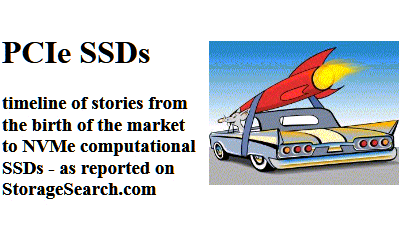 |
|
| leading the way to the
new storage frontier |
.. | |
| |
| .. |
linking Diablo to A3CUBE"Having SSDs located in a DIMM
socket in one server - no longer precludes that very same data being accessed by
another server as if it were just a locally installed PCIe SSD"
So
said Zsolt
Kerekes, editor - StorageSearch.com
on September 23, 2014.
The context was 2
news stories (archived
below) which linked
Diablo to A3CUBE. |
| .. |
|
| .. |
Diablo is the #1 SSD
company being followed up in recent weeks
Editor:- September 23,
2014 - StorageSearch.com
doesn't publish a regular list of the Top SSD Companies searched for by readers
in the 1st 3 weeks of September. That's because
7+ years of Top SSD
company tracker company history has demonstrated that 3 month (quarterly)
sampling periods are more reliable (than 3 weeks). But if we did - a 3 week
tracker - the #1 company this month would be - Diablo.
In
particular readers are looking at
Diablo's FMS 2014
presentation (pdf) from which I extracted these key features in earlier
memory channel
SSDs news coverage in
August.
- Diablo's converged memory architecture (flash tiered with DRAM) is planned
to support 700 million random cachelines / sec.
- Latency of each cacheline is about 48 nanoseconds.
- Diablo's NanoCommit supports byte addressable small writes to flash with
high transaction rates and the ability to mirror the DRAM contents to
persistent storage.
- The combination of technologies would enable something like a 1U server
with 25TB of converged memory.
Editor's comments:- I only
mention it - because of the scale of interest involved.
One reason may
be that - as you'll see in the next news story below - having SSDs located in a
DIMM socket in one server - no longer precludes that very same data being
accessed by another server as if it were just a locally installed PCIe SSD.
BTW
- A3CUBE is #2
in September reader followups so far - and this is due to the story below.
A3CUBE - first US customer shipments soon
Editor:-
September 18, 2014 - earlier this week
A3CUBE
effectively announced
imminent US customer shipments of its PCIe connected shared reflective memory
fabric - with the unveiling of the system software which works with its
previously announced RONNIEE Express platform.
The
Fortissimo
Foundation software (overview pdf) is the new management and OS software
which enables application agnostic hardware based memory synchronization of
DRAM memory blocks across multiple servers (scalable to thousands) which are
connected via a PCIe fabric with worst case access times under 1 micro-second
(which includes operating system and software overhead). This enables access to
all the resources in the cluster as if they were local.

Editor's
comments:- Before talking to Emilio Billi,
Founder - A3CUBE last week about the new Fortissimo - 3 ideas popped into my
head.
- modeling the application performance
I realized that in
the absence of any other data (at this stage of the product's life cycle)- a
good predictive analog for the usability of this remote shared memory system
would be Diablo's memory
channel SSD architecture.
The key difference being that the 1st
generation MCS has typical latencies around 3 to 5 microseconds (compared to
800nS RONNIEE Express), and MCS is operating with flash - whereas RE operates
with DRAM. But as a first order approximation -my thinking was that any app
which works well with MCS in a local server - will work just as well - or better
- in a remote server connected by RE.
- the importance of strategic software standard support
My
guess is that for many smaller developers of large memory architecture systems
- SanDisk's ZetaScale
(and related) APIs will come to be regarded as a "safe" hardware
independent SSD software platform for flash. So - if it was easy to integrate
A3CUBE's Fortissimo / RE within such APIs - that would provide a gateway to a
much bigger market.
- beyond legacy storage and SSD fabrics
Obviously to get
business now - A3CUBE has to demonstrate that their products can be useful and
competitive when used with existing storage and SSD installations and
architectures.
But as more of the installed base moves towards
new dynasty
(always intended to include SSDs at the outset), and in the next 5 to 10 years
as we see the current new generations of "software as something useful in
an SSD server" - give way to new
SSD software
ecosystems - developed by stealth mode companies like
Primary Data -
whose products don't even exist yet (except as tantalizing
investment objects and
patent applications) - I could see that the A3CUBE style of connection - would
still fit in well - because the ability to replicate and synchronize
remote memory in multiple servers at latencies which are closer to hardware than
software - isn't going to go oyt of fashion. So I mentioned all those
things to Emilio when we spoke. And this is what I learned.
- Emilio said Diablo was one of the first external companies to recognize the
work that A3CUBE was doing. And he said that Diablo's APIs should work
easily with A3CUBE's platform (just as many other memory intensive apps).
And
- as I speculated before our conversation - the ability to seamlessly converge
remote low latency RAM with remote flash across an almost unlimited set of
servers - is a mind boggling ecosystem enabler. Because we should now view SSD
memory products which do useful things locally in a single server - as simply a
subset of a continuum which can span racks and cabinets - and change not only
cost dynamics - but the very determination of what type of apps are possible.
- Emilio said a significant bottleneck in all previous fabric systems was
the mechanism of metadata synchronization.
That's traditionally done
in software - and no matter how many hundreds or thousands of servers you have
in your installation - the scalability of those systems ultimately comes back to
the software mechanism of how fast 2 servers can replicate or share a set of
data.
In A3CUBE's RE platform - the ability to broadcast an identical
content of shared memory across hundreds or thousands of connected nodes is
done in silicon.
- re reliability? - I put it to Emilio that everything was being staked on
the reliability of the RE platform - and I asked more about that.
Emilio
said that the Fortissimo / RE system can be configured to drop back to an
ethernet fabric if the core RE fails - but if budget allows - then it can fall
back to another RE. In neither event do you lose data or access to data. A3CUBE
has been collecting reliability data from their early access systems - and will
publish more about that later.
- re when can customers order these systems?
Emilio said that the
first production system is already scheduled for delivery to a US customer next
month.
So to my way of looking at it - the general availability
issue just seems to be related to how many of the software features are nice to
have versus essential. That will depend on what the applications are.
- re my other points - Emilio said that legacy big memory software platforms
are already supported by Fortissimo (see their site for more details) and we
found a lot to agree about re the other things I mentioned above.
| |
| . |
| today's SSD news |
| . |
| In September 2005 -
SimpleTech (STEC) launched the world's first dual interface SSD. At launch time
the Zeus Dual Interface SSD, with both a USB and SATA interface, offered
capacities up to 192GB in a 3.5-inch form factor, and sustained read/write rates
of 60 MBytes per second. |
| SSD market
history | | |
| . |
|

| |
| .. |
|
|
. |
|
This year - as part of a
continuing trend - we've seen an upswing in the number of companies who offer
PCIe compatible SSDs in form factors like M.2 and 2.5".
The barriers to market have been reduced by standards such as NVMe and
SATA express - which by creating frameworks of software and hardware
interchangeability - have minimized the risks for oems who incoprorate such SSDs
into their storage and computing systems.
|
| 12 key SSD
ideas which changed in 2014 | | |
|
.
.
. |
|
|
|
.
.
. |
|
 |
|
.
.
. |
|
SSD is a disruptive market
and doesn't only replace old ways of doing things - but will create new markets
that didn't exist before and which couldn't have existed before SSDs reached a
threshold level of awareness and affordability.
That's why all the
traditional ways of prediction can't help but understate the ultimate size of
the SSD market. |
| The big market impact of
SSD dark matter | | |
|
.
.
. |
|
| There is much evidence to
support the idea that both applications performance and data storage efficiency
can be greatly improved if the flash management and apps management processor
are either the same CPU - or if they can talk to each other in a more effective
way. |
in-situ SSD processing
1 of 10 key
SSD ideas in 2014 | | |
|
.
.
. |
|
| "I think
SanDisk's ZetaScale could be one of the most significant SSD software products
launched in 2014 - because of the freedom it will give big memory customers
about how they navigate their tactical choices of low latency flash SSD
hardware." |
| Zsolt Kerekes,
editor - StorageSearch.com
- SSD news (July
8, 2014) | | |
|
.
.
. |
|
| PLX started out
with the intention of using the ExpressFabric box as a system design tool to
help server oems and PCIe SSD designers get a feel for how they could expand
their product offerings by scaling the fabric using PCIe instead of ethernet or
InfiniBand. |
| An SSD conversation
with PLX - June 5, 2014 | | |
|
.
.
. |
|
|
|
.
.
. |
|
 | |








